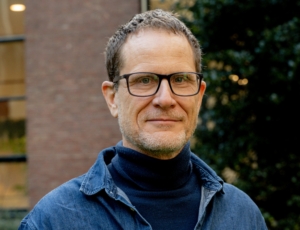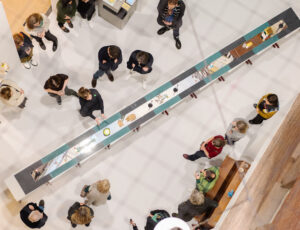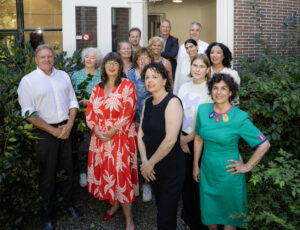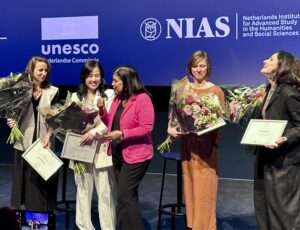You were appointed rector of NIAS in November last year. What was your connection to NIAS?
“My first experience of NIAS was as a Fellow in 2004/05. I was enthusiastic about the opportunities NIAS offered: the facilities, the space to study and write on my research in the field of psychology, but especially to be a part of a diverse scientific community. Before I arrived, I could not imagine what the ‘community of scholars’ would mean but once I started work I found out how enriching it is to discuss various topics with scientists from different disciplines. I learnt a lot that year. After my fellowship, I became a member, and later chair, of NIAS’ scholarship committee. We had to evaluate the fellowship proposals for the coming year. An extremely interesting and challenging task.”
Rector in Difficult Financial Times
In May 2013, the Royal Academy of Arts and Sciences (KNAW) announced it was to cut NIAS’ budget by a third. Emmelkamp: “They did not give a good reason for hitting NIAS so hard, at least not in my opinion. As chair of the scholarship committee at the time I had many heated discussions to try to prevent this enormous cutback, but to no avail. So when the KNAW asked me whether I was prepared to become the new rector and prepare NIAS for the move to Amsterdam, I thought, ‘well, if the decision to cut the budget is not negotiable then the least I can do is try to carry out the process in the best possible way.’ That’s the reason I took on this job.”
And how is it going so far?
“Well, it has certainly not been easy. The budget cuts will have consequences for the staff as well as the number of Fellows at NIAS. And, because the plan to group a number of the KNAW’s humanities institutes together in Amsterdam has been delayed, the NIAS reorganization plan has had to be postponed. This means that uncertainty is prolonged, which is not good for staff morale or for potential fellows.”
So when you drive to work in the morning, what are your thoughts on another day at NIAS?
“Each morning, when I arrive at NIAS, I look around me and I enjoy the place as it is. But on the other hand, given our financial problems, the only solution is to join forces with other institutes, which means having to leave this location in Wassenaar. So every morning, when I get out of my car, I think the same, ‘it is a pity, but we have no other option’.”
Moving to Amsterdam
There has been a lot of opposition from (former) fellows with regard to the planned move to Amsterdam as well as the clustering of the humanities institutes…
“I understand their viewpoint. But, I am rather surprised that the fellows’ main objection is about the move to Amsterdam. They seem to be more focused on NIAS’ location than the disproportionately heavy budget cuts, which I see as the biggest problem. The decision to withhold a third of our funding poses a far greater threat. Whereas it is clear that the Netherlands, like other countries across the globe, needs an Institute for Advanced Study to support advanced research and to stimulate interaction between the sciences.”
So when you envision NIAS’ future, what do you see?
“A NIAS that is housed in a suitable, appropriate building in a central location in Amsterdam. Although it will be totally different from NIAS in Wassenaar, it should be remembered that most Institutes for Advanced Study in the world are successfully located in large cities. For example, I recently visited the WIKO in Berlin and the Helsinki Collegium for Advanced Studies. The fellows I spoke there seem quite happy to be in the city. A location in Amsterdam will have some disadvantages but definitely has a lot of advantages for fellows. For example, NIAS will be easier to reach, it will be easier for fellows to meet up with other scholars from the Netherlands and abroad and it will be easier to access collections and libraries.”
Broadening the scope
Besides NIAS’ location, do you foresee other changes in policy?
“We are considering broadening the institute’s scope. NIAS is traditionally very strong in the humanities. But, for example, social scientists are underrepresented because, amongst other things, it is difficult for social scientists to leave their labs for months at a time. We already have the NIAS-Lorentz Program which bridges the gap between social sciences/humanities and the beta sciences. And I hope we will be able to attract more scholars from disciplines besides the humanities in the future. Being located in Amsterdam will definitely make it easier for a greater variety of scholars to visit for shorter periods. To benefit from this NIAS will need to be more flexible in the kind of fellowships it offers than has been the case up to now.”
One final question: NIAS offers ‘the environment and time to generate new ideas’. Have you had first-hand experience of this happening?
“Yes indeed, in fact only this morning a historian Jeroen Duindam and I had a fascinating discussion on using computer models that analyse the spread of information via networks. Scholars from computing and physics, who are fellows at NIAS, use current data to model and predict future social behaviour. However, as proof of the pudding they can feed historical data into their models to test their predictive power. In this way the computer model’s outcomes can be checked against actual historical reality. This idea was welcomed and may be investigated. It is this kind of cross-pollination that can only flourish in an interdisciplinary institute such as NIAS.”
Janusz Holyst, member of the theme group on modelling the spread of information via networks, talking to a NIAS colleague.



